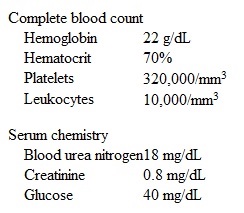A newborn boy is evaluated on arrival in the nursery. He was born 3 hours ago by spontaneous vaginal delivery at 40 weeks gestation after an uncomplicated pregnancy. Apgar scores were 9 at 1 minute and 10 at 5 minutes after birth. His mother has no significant medical history and does not take any medications. Temperature is 36.7 C (98 F) , pulse is 124/min, and respirations are 26/min. He is awake, alert, and active with a strong cry. His head is normocephalic and atraumatic with an open flat anterior fontanelle. Pupils are equal and reactive to light and accommodation, and red reflexes are present bilaterally. The nares are patent, there is no cleft lip or palate, and the pharynx is not erythematous. Clavicles are intact without crepitus. S1 and S2 are normal without murmurs, and lungs are clear to auscultation bilaterally. The abdomen is soft, nontender, and nondistended with normal bowel sounds and no organomegaly. Femoral pulses are normal and symmetrical. All extremities move spontaneously and there is no edema. There are no rashes, skin lesions, or jaundice, but the complexion appears ruddy with generalized erythema. Blood samples obtained from the heel through simple prick method reveal a hematocrit of 70%. Repeat testing revealed a hematocrit of 65%. The patient is re-evaluated in the nursery and appears comfortable, with no tachycardia or respiratory distress. He feeds slowly but has no emesis, and voids spontaneously after his first feed. A decision is made to observe the child without intervention. Approximately 12 hours later, he appears irritable and lethargic. The infant has refused all subsequent feeds and has had decreased urine output. Nursery staff observed an episode of apnea. Temperature is 37.4 C (99.3 F) , pulse is 170/min, and respirations are 60/min. Physical examination shows a drowsy, hypotonic, poorly responsive newborn. The fontanelle is open and flat. Pupils are equal and reactive with normal red reflexes. There is no rhinorrhea. Oral mucosa is moist. S1 and S2 are present without murmurs. On pulmonary examination there are no wheezes or rales, but there are intercostal retractions. The skin is erythematous and ruddy, and there is cyanosis of the fingertips. There are no focal neurologic deficits. Laboratory results from peripheral blood draw are as follows: The patient is transferred to the neonatal intensive care unit, and treatment with intravenous fluids and glucose is initiated. His symptoms fail to improve, and his hematocrit after several hours is 71%. What is the most appropriate next step in management of this patient?
The patient is transferred to the neonatal intensive care unit, and treatment with intravenous fluids and glucose is initiated. His symptoms fail to improve, and his hematocrit after several hours is 71%. What is the most appropriate next step in management of this patient?
Definitions:
Amortization
The process of spreading the cost of an intangible asset over its useful life or paying off a loan in regular installments over a period.
Interest Expense
The cost incurred by an entity for borrowed funds, including loans, bonds, or lines of credit.
Mortgage Note Payable
A long-term liability document that spells out the terms under which a borrower agrees to repay a sum of money to a lender, typically secured by real estate.
Loan Principal
The amount of money that is borrowed and must be repaid, excluding any interest or additional fees.
Q7: A 31-year-old woman, gravida 1 para 0,
Q35: A 38-year-old woman, gravida 2 para 0
Q107: A 74-year-old woman is brought to the
Q256: A 24-year-old woman comes to the physician
Q290: A 46-year-old female comes with a two-week
Q350: A 46-year-old man comes to the office
Q475: A 48-year-old man comes to the emergency
Q525: An 18-year-old woman comes to the emergency
Q593: A 55-year-old woman comes to the emergency
Q701: A 32-year-old female comes to the physician's